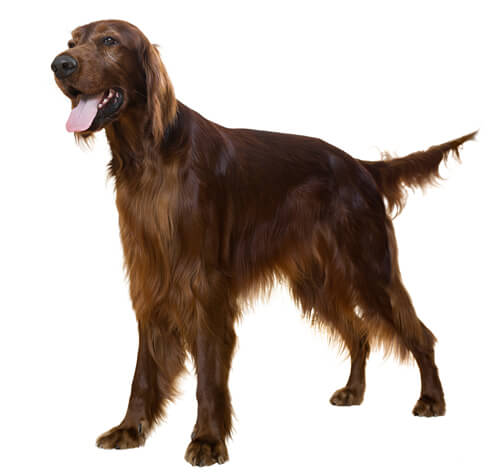
Irish Setter
An aristocratic bird dog known for his style, powerful movement and clown-like personality, the Irish Setter became popular in the 18th century throughout Ireland and the British Isles. This merry, friendly breed has a stable, outgoing temperament, making him a great family companion. The Irish Setter requires regular exercise, and his long, glossy, red coat must be groomed regularly.
DID YOU KNOW? The famed “Dog Whisperer” Cesar Millan’s first pet was an Irish Setter named “Saluki.”
ALSO KNOWN AS: Red Setter, Irish Red Setter
The need-to-know
- Dog suitable for non-experienced owners
- Some training required
- Enjoys vigorous walks
- Enjoys walking more than two hours a day
- Large dog
- Some drool
- Requires grooming every other day
- Non hypoallergenic breed
- Quiet dog
- Not a guard dog
- May require training to live with other pets
- Great family dog
Personality

The well-bred, well-socialised and well-trained Irish Setter is extraordinarily sweet and makes an affectionate, loyal family pet. Early exposure to cats and careful supervision is essential if they are to share a home with them - and they may not be safe with strange cats or any small furry animals.
Being terribly friendly, this is not a good guard dog, though he will announce the presence of a visitor. The Irish Setter remains playful throughout his life - one of his more endearing traits. They are often thought of as being a bit ditzy and brainless - or even highly strung - but this is generally because people buy them for their glamour and underestimate how much exercise and input this working dog needs to stay healthy and happy.
History and Origins

Country of Origin: Ireland
The setter group are dogs who hunt game birds silently and largely by scent, then when they locate them, ‘set’ (crouch or lie down) rather than flush or chase.
The Irish Setter is the oldest of the setter group, preceding both the Gordon and English Setters. It is believed the breed developed from old spaniels and indeed the breed was originally called the Red Spaniel. While the breed was developed as a setter for netting birds, it later became a more general gundog and could be trained as a pointer as well. Their eye-catching colour led them effortlessly into the show ring where the breed was further glamourised by adding influences from breeds such as the Borzoi. Despite that, they remained an efficient and energetic hunting dog - a perfect mix of beauty and brains.
Nutrition and Feeding

Large breed dogs, as well as having large appetites, benefit from a different balance of nutrients including minerals and vitamins compared to smaller-breed dogs. Irish Setters need to have a balanced diet including the main nutrient groups and a constant supply of fresh water. They are prone to bloating and stomach problems; smaller, more frequent meals can help minimise this risk.
Exercise

The Irish Setter was bred to work all day every day and is very active so needs a lot of dog exercise – two-plus hours daily for an adult. This needs to include free-running and the opportunity to sniff and explore. Not a dog for couch potatoes.
Other Information

Health and Common Concerns
As with many breeds, the Irish Setter dog can suffer from various hereditary eye disorders, and hip dysplasia (a condition that can lead to mobility problems). Eye testing and hip scoring of dogs prior to breeding is therefore important. They can also be prone to gastrointestinal disorders. In the 1940s the breed was nearly decimated by the eye disease progressive retinal atrophy, better known as PRA. Due to the development of a DNA test to identify carriers, the breed has recovered and the incidence of PRA has dropped dramatically.
Space Requirements
This is a large, country dog and so really needs both indoor and outdoor space - as well as access to the countryside.
Training Irish Setters
This is a dog who loves working with their owner and with positive reward-based training can be extremely obedient. Irish Setters are however still hunters at heart and are easily distracted so recall can be an issue if they get distracted by scents, sights - or something to chase. Pet gun dog classes or scentwork classes can be invaluable to help give them an outlet for their hardwired behaviours.
Best Family Dog Breeds
The Irish Setter can make the perfect family dog as they love everyone of all ages. They may be too bouncy for very small children but for an active family, they are hard to beat. While many dogs are traditionally thought of as being good with children, all dogs and children need to be taught to get on with each other and be safe together. Even so, dogs and young children should never be left alone together and adults should supervise all interactions between them.
Did You Know?
- The Irish Setter is also often called the Red Setter (or Madra rua – which means red dog in Gaelic) because of his stunning coat. It is said that the same gene that makes the Irish Setter red is the same one that is found in Irish and Scottish people to give so many of them ginger hair and freckles!
- Two Irish Setters have found their way into the White House – one called Mike owned by Harry Truman, and the other called King Timahoe owned by Richard Nixon. Despite having such a royal name, King Timahoe disgraced himself by shredding a carpet in the Oval Office!